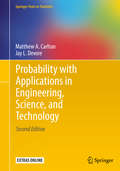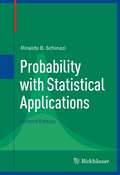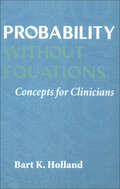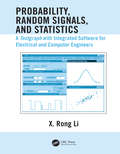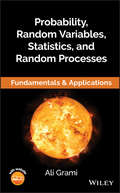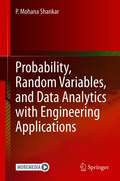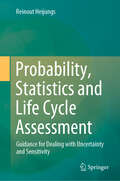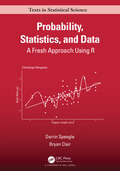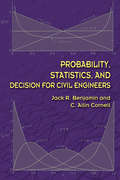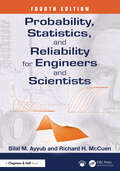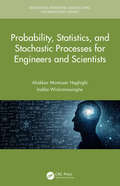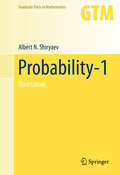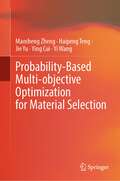- Table View
- List View
Probability on Graphs
by Geoffrey GrimmettThis introduction to some of the principal models in the theory of disordered systems leads the reader through the basics, to the very edge of contemporary research, with the minimum of technical fuss. Topics covered include random walk, percolation, self-avoiding walk, interacting particle systems, uniform spanning tree, random graphs, as well as the Ising, Potts, and random-cluster models for ferromagnetism, and the Lorentz model for motion in a random medium. Schramm-Löwner evolutions (SLE) arise in various contexts. The choice of topics is strongly motivated by modern applications and focuses on areas that merit further research. Special features include a simple account of Smirnov's proof of Cardy's formula for critical percolation, and a fairly full account of the theory of influence and sharp-thresholds. Accessible to a wide audience of mathematicians and physicists, this book can be used as a graduate course text. Each chapter ends with a range of exercises.
Probability on Graphs: Random Processes on Graphs and Lattices (Institute of Mathematical Statistics Textbooks #8)
by Geoffrey GrimmettThis introduction to some of the principal models in the theory of disordered systems leads the reader through the basics, to the very edge of contemporary research, with the minimum of technical fuss. Topics covered include random walk, percolation, self-avoiding walk, interacting particle systems, uniform spanning tree, random graphs, as well as the Ising, Potts, and random-cluster models for ferromagnetism, and the Lorentz model for motion in a random medium. Schramm-Lwner evolutions (SLE) arise in various contexts. The choice of topics is strongly motivated by modern applications and focuses on areas that merit further research. Special features include a simple account of Smirnov's proof of Cardy's formula for critical percolation, and a fairly full account of the theory of influence and sharp-thresholds. Accessible to a wide audience of mathematicians and physicists, this book can be used as a graduate course text. Each chapter ends with a range of exercises.
Probability on Real Lie Algebras
by Uwe Franz Nicolas PrivaultThis monograph is a progressive introduction to non-commutativity in probability theory, summarizing and synthesizing recent results about classical and quantum stochastic processes on Lie algebras. In the early chapters, focus is placed on concrete examples of the links between algebraic relations and the moments of probability distributions. The subsequent chapters are more advanced and deal with Wigner densities for non-commutative couples of random variables, non-commutative stochastic processes with independent increments (quantum Lévy processes), and the quantum Malliavin calculus. This book will appeal to advanced undergraduate and graduate students interested in the relations between algebra, probability, and quantum theory. It also addresses a more advanced audience by covering other topics related to non-commutativity in stochastic calculus, Lévy processes, and the Malliavin calculus.
Probability with Applications in Engineering, Science, and Technology
by Jay L. Devore Matthew A. CarltonThis book provides a contemporary and lively postcalculus introduction to the subject of probability. The exposition reflects a desirable balance between fundamental theory and many applications involving a broad range of real problem scenarios. It is intended to appeal to a wide audience, including mathematics and statistics majors, prospective engineers and scientists, and those business and social science majors interested in the quantitative aspects of their disciplines. A one-term course would cover material in the core chapters (1-4), hopefully supplemented by selections from one or more of the remaining chapters on statistical inference (Ch. 5), Markov chains (Ch. 6), stochastic processes (Ch. 7), and signal processing (Ch. 8). The last chapter is specifically designed for electrical and computer engineers, making the book suitable for a one-term class on random signals and noise. Alternatively, there is certainly enough material for those lucky enough to be teaching or taking a year-long course. Most of the core will be accessible to those who have taken a year of univariate differential and integral calculus; matrix algebra, multivariate calculus, and engineering mathematics are needed for the later, more advanced chapters. One unique feature of this book is the inclusion of sections that illustrate the importance of software for carrying out simulations when answers to questions cannot be obtained analytically; R and Matlab code are provided so that students can create their own simulations. Another feature that sets this book apart is the Introduction, which addresses the question "Why study probability?" by surveying selected examples from recent journal articles and discussing some classic problems whose solutions run counter to intuition. The book contains about 1100 exercises, ranging from straightforward to reasonably challenging; roughly 700 of these appear in the first four chapters. The book's preface provides more information about our purpose, content, mathematical level, and suggestions for what can be covered in courses of varying duration.
Probability with Applications in Engineering, Science, and Technology
by Jay L. Devore Matthew A. CarltonThis book provides a contemporary and lively postcalculus introduction to the subject of probability. The exposition reflects a desirable balance between fundamental theory and many applications involving a broad range of real problem scenarios. It is intended to appeal to a wide audience, including mathematics and statistics majors, prospective engineers and scientists, and those business and social science majors interested in the quantitative aspects of their disciplines. A one-term course would cover material in the core chapters (1-4), hopefully supplemented by selections from one or more of the remaining chapters on statistical inference (Ch. 5), Markov chains (Ch. 6), stochastic processes (Ch. 7), and signal processing (Ch. 8). The last chapter is specifically designed for electrical and computer engineers, making the book suitable for a one-term class on random signals and noise. Alternatively, there is certainly enough material for those lucky enough to be teaching or taking a year-long course. Most of the core will be accessible to those who have taken a year of univariate differential and integral calculus; matrix algebra, multivariate calculus, and engineering mathematics are needed for the later, more advanced chapters. One unique feature of this book is the inclusion of sections that illustrate the importance of software for carrying out simulations when answers to questions cannot be obtained analytically; R and Matlab code are provided so that students can create their own simulations. Another feature that sets this book apart is the Introduction, which addresses the question "Why study probability?" by surveying selected examples from recent journal articles and discussing some classic problems whose solutions run counter to intuition. The book contains about 1100 exercises, ranging from straightforward to reasonably challenging; roughly 700 of these appear in the first four chapters. The book's preface provides more information about our purpose, content, mathematical level, and suggestions for what can be covered in courses of varying duration.
Probability with Martingales
by David WilliamsThis is a masterly introduction to the modern and rigorous theory of probability. The author adopts the martingale theory as his main theme and moves at a lively pace through the subject's rigorous foundations. Measure theory is introduced and then immediately exploited by being applied to real probability theory. Classical results, such as Kolmogorov's Strong Law of Large Numbers and Three-Series Theorem are proved by martingale techniques. A proof of the Central Limit Theorem is also given. The author's style is entertaining and inimitable with pedagogy to the fore. Exercises play a vital role; there is a full quota of interesting and challenging problems, some with hints.
Probability with R: An Introduction with Computer Science Applications
by Jane M. HorganProvides a comprehensive introduction to probability with an emphasis on computing-related applications This self-contained new and extended edition outlines a first course in probability applied to computer-related disciplines. As in the first edition, experimentation and simulation are favoured over mathematical proofs. The freely down-loadable statistical programming language R is used throughout the text, not only as a tool for calculation and data analysis, but also to illustrate concepts of probability and to simulate distributions. The examples in Probability with R: An Introduction with Computer Science Applications, Second Edition cover a wide range of computer science applications, including: testing program performance; measuring response time and CPU time; estimating the reliability of components and systems; evaluating algorithms and queuing systems. Chapters cover: The R language; summarizing statistical data; graphical displays; the fundamentals of probability; reliability; discrete and continuous distributions; and more. This second edition includes: improved R code throughout the text, as well as new procedures, packages and interfaces; updated and additional examples, exercises and projects covering recent developments of computing; an introduction to bivariate discrete distributions together with the R functions used to handle large matrices of conditional probabilities, which are often needed in machine translation; an introduction to linear regression with particular emphasis on its application to machine learning using testing and training data; a new section on spam filtering using Bayes theorem to develop the filters; an extended range of Poisson applications such as network failures, website hits, virus attacks and accessing the cloud; use of new allocation functions in R to deal with hash table collision, server overload and the general allocation problem. The book is supplemented with a Wiley Book Companion Site featuring data and solutions to exercises within the book. Primarily addressed to students of computer science and related areas, Probability with R: An Introduction with Computer Science Applications, Second Edition is also an excellent text for students of engineering and the general sciences. Computing professionals who need to understand the relevance of probability in their areas of practice will find it useful.
Probability with Statistical Applications
by Rinaldo B. SchinaziThis second edition textbook offers a practical introduction to probability for undergraduates at all levels with different backgrounds and views towards applications. Calculus is a prerequisite for understanding the basic concepts, however the book is written with a sensitivity to students' common difficulties with calculus that does not obscure the thorough treatment of the probability content. The first six chapters of this text neatly and concisely cover the material traditionally required by most undergraduate programs for a first course in probability. The comprehensive text includes a multitude of new examples and exercises, and careful revisions throughout. Particular attention is given to the expansion of the last three chapters of the book with the addition of one entirely new chapter (9) on 'Finding and Comparing Estimators.' The classroom-tested material presented in this second edition forms the basis for a second course introducing mathematical statistics.
Probability without Equations: Concepts for Clinicians
by Bart K. HollandAn award-winning teacher gives a non-technical explanation of the probability and statistics needed by physicians to interpret laboratory results.Although few physicians, nurses, dentists, and other health professionals perform laboratory tests themselves, they all need to be able to interpret the results as well as understand findings reported in the medical literature. A general understanding of probability and statistics is essential for those needing to make daily decisions about the significance of research data, drug interaction precautions, or a patient's positive laboratory test for a rare disease.Written with these needs in mind, Probability without Equations offers a thorough explanation of the subject without overwhelming the reader with equations and footnotes. Award-winning teacher Bart Holland presents a nontechnical treatment of intuitive concepts and presents numerous examples from medical research and practice. In plain language, this book explains the topics that clinicians need to understand:• Analysis of variance• "P-values" and the "t-test"• Hazard models• Regression and correlations• Alpha and beta errors"The Nobel prize-winning physicist Ernest Rutherford was fond of saying that if you need statistics to analyze the results of an experiment, you don't have a very good experiment. In a way he was right. However, a recurrent problem in medicine is that in a certain sense you commonly don't have a good experiment—but not because medical research scientists are generally incompetent! The nature of the data they work with is simply not as predictable as the data in some other fields, so the predictive nature of findings in medical science is generally rather imperfect."—from the introduction
Probability, Decisions and Games: A Gentle Introduction using R
by Abel Rodríguez Bruno MendesINTRODUCES THE FUNDAMENTALS OF PROBABILITY, STATISTICS, DECISION THEORY, AND GAME THEORY, AND FEATURES INTERESTING EXAMPLES OF GAMES OF CHANCE AND STRATEGY TO MOTIVATE AND ILLUSTRATE ABSTRACT MATHEMATICAL CONCEPTS Covering both random and strategic games, Probability, Decisions and Games features a variety of gaming and gambling examples to build a better understanding of basic concepts of probability, statistics, decision theory, and game theory. The authors present fundamental concepts such as random variables, rational choice theory, mathematical expectation and variance, fair games, combinatorial calculus, conditional probability, Bayes Theorem, Bernoulli trials, zero-sum games and Nash equilibria, as well as their application in games such as Roulette, Craps, Lotto, Blackjack, Poker, Rock-Paper-Scissors, the Game of Chicken and Tic-Tac-Toe. Computer simulations, implemented using the popular R computing environment, are used to provide intuition on key concepts and verify complex calculations. The book starts by introducing simple concepts that are carefully motivated by the same historical examples that drove their original development of the field of probability, and then applies those concepts to popular contemporary games. The first two chapters of Probability, Decisions and Games: A Gentle Introduction using R feature an introductory discussion of probability and rational choice theory in finite and discrete spaces that builds upon the simple games discussed in the famous correspondence between Blaise Pascal and Pierre de Fermat. Subsequent chapters utilize popular casino games such as Roulette and Blackjack to expand on these concepts illustrate modern applications of these methodologies. Finally, the book concludes with discussions on game theory using a number of strategic games. This book: · Features introductory coverage of probability, statistics, decision theory and game theory, and has been class-tested at University of California, Santa Cruz for the past six years · Illustrates basic concepts in probability through interesting and fun examples using a number of popular casino games: roulette, lotto, craps, blackjack, and poker · Introduces key ideas in game theory using classic games such as Rock-Paper-Scissors, Chess, and Tic-Tac-Toe. · Features computer simulations using R throughout in order to illustrate complex concepts and help readers verify complex calculations · Contains exercises and approaches games and gambling at a level that is accessible for readers with minimal experience · Adopts a unique approach by motivating complex concepts using first simple games and then moving on to more complex, well-known games that illustrate how these concepts work together Probability, Decisions and Games: A Gentle Introduction using R is a unique and helpful textbook for undergraduate courses on statistical reasoning, introduction to probability, statistical literacy, and quantitative reasoning for students from a variety of disciplines. ABEL RODRÍGUEZ, PhD, is Professor in the Department of Applied Mathematics and Statistics at the University of California, Santa Cruz (UCSC), CA, USA. The author of 40 journal articles, his research interests include Bayesian nonparametric methods, machine learning, spatial temporal models, network models, and extreme value theory. BRUNO MENDES, PhD, is Lecturer in the Department of Applied Mathematics and Statistics at the University of California, Santa Cruz, CA, USA. BRUNO MENDES, PhD, is Lecturer in the Department of Applied Mathematics and Statistics at the University of Cal
Probability, Markov Chains, Queues, and Simulation: The Mathematical Basis of Performance Modeling
by William J. StewartProbability, Markov Chains, Queues, and Simulation provides a modern and authoritative treatment of the mathematical processes that underlie performance modeling. The detailed explanations of mathematical derivations and numerous illustrative examples make this textbook readily accessible to graduate and advanced undergraduate students taking courses in which stochastic processes play a fundamental role. The textbook is relevant to a wide variety of fields, including computer science, engineering, operations research, statistics, and mathematics.The textbook looks at the fundamentals of probability theory, from the basic concepts of set-based probability, through probability distributions, to bounds, limit theorems, and the laws of large numbers. Discrete and continuous-time Markov chains are analyzed from a theoretical and computational point of view. Topics include the Chapman-Kolmogorov equations; irreducibility; the potential, fundamental, and reachability matrices; random walk problems; reversibility; renewal processes; and the numerical computation of stationary and transient distributions. The M/M/1 queue and its extensions to more general birth-death processes are analyzed in detail, as are queues with phase-type arrival and service processes. The M/G/1 and G/M/1 queues are solved using embedded Markov chains; the busy period, residual service time, and priority scheduling are treated. Open and closed queueing networks are analyzed. The final part of the book addresses the mathematical basis of simulation.Each chapter of the textbook concludes with an extensive set of exercises. An instructor's solution manual, in which all exercises are completely worked out, is also available (to professors only).Numerous examples illuminate the mathematical theoriesCarefully detailed explanations of mathematical derivations guarantee a valuable pedagogical approachEach chapter concludes with an extensive set of exercises
Probability, Random Processes, and Statistical Analysis
by Hisashi Kobayashi Brian L. Mark William TurinTogether with the fundamentals of probability, random processes, and statistical analysis, this insightful book also presents a broad range of advanced topics and applications. There is extensive coverage of Bayesian vs. frequentist statistics, time series and spectral representation, inequalities, bound and approximation, maximum-likelihood estimation and the expectation-maximization (EM) algorithm, geometric Brownian motion and Itô process. Applications such as hidden Markov models (HMM), the Viterbi, BCJR, and Baum-Welch algorithms, algorithms for machine learning, Wiener and Kalman filters, queueing and loss networks, and are treated in detail. The book will be useful to students and researchers in such areas as communications, signal processing, networks, machine learning, bioinformatics, econometrics and mathematical finance. With a solutions manual, lecture slides, supplementary materials, and MATLAB programs all available online, it is ideal for classroom teaching as well as a valuable reference for professionals.
Probability, Random Signals, and Statistics
by X. Rong LiWith this innovative text, the study-and teaching- of probability and random signals becomes simpler, more streamlined, and more effective. Its unique "textgraph" format makes it both student-friendly and instructor-friendly. Pages with a larger typeface form a concise text for basic topics and make ideal transparencies; pages with smaller type provide more detailed explanations and more advanced material.
Probability, Random Variables, Statistics, and Random Processes: Fundamentals & Applications
by Ali GramiProbability, Random Variables, Statistics, and Random Processes: Fundamentals & Applications is a comprehensive undergraduate-level textbook. With its excellent topical coverage, the focus of this book is on the basic principles and practical applications of the fundamental concepts that are extensively used in various Engineering disciplines as well as in a variety of programs in Life and Social Sciences. The text provides students with the requisite building blocks of knowledge they require to understand and progress in their areas of interest. With a simple, clear-cut style of writing, the intuitive explanations, insightful examples, and practical applications are the hallmarks of this book. The text consists of twelve chapters divided into four parts. Part-I, Probability (Chapters 1 – 3), lays a solid groundwork for probability theory, and introduces applications in counting, gambling, reliability, and security. Part-II, Random Variables (Chapters 4 – 7), discusses in detail multiple random variables, along with a multitude of frequently-encountered probability distributions. Part-III, Statistics (Chapters 8 – 10), highlights estimation and hypothesis testing. Part-IV, Random Processes (Chapters 11 – 12), delves into the characterization and processing of random processes. Other notable features include: Most of the text assumes no knowledge of subject matter past first year calculus and linear algebra With its independent chapter structure and rich choice of topics, a variety of syllabi for different courses at the junior, senior, and graduate levels can be supported A supplemental website includes solutions to about 250 practice problems, lecture slides, and figures and tables from the text Given its engaging tone, grounded approach, methodically-paced flow, thorough coverage, and flexible structure, Probability, Random Variables, Statistics, and Random Processes: Fundamentals & Applications clearly serves as a must textbook for courses not only in Electrical Engineering, but also in Computer Engineering, Software Engineering, and Computer Science.
Probability, Random Variables, and Data Analytics with Engineering Applications
by P. Mohana ShankarThis book bridges the gap between theory and applications that currently exist in undergraduate engineering probability textbooks. It offers examples and exercises using data (sets) in addition to traditional analytical and conceptual ones. Conceptual topics such as one and two random variables, transformations, etc. are presented with a focus on applications. Data analytics related portions of the book offer detailed coverage of receiver operating characteristics curves, parametric and nonparametric hypothesis testing, bootstrapping, performance analysis of machine vision and clinical diagnostic systems, and so on. With Excel spreadsheets of data provided, the book offers a balanced mix of traditional topics and data analytics expanding the scope, diversity, and applications of engineering probability. This makes the contents of the book relevant to current and future applications students are likely to encounter in their endeavors after completion of their studies. A full suite of classroom material is included. A solutions manual is available for instructors. Bridges the gap between conceptual topics and data analytics through appropriate examples and exercises; Features 100's of exercises comprising of traditional analytical ones and others based on data sets relevant to machine vision, machine learning and medical diagnostics;Intersperses analytical approaches with computational ones, providing two-level verifications of a majority of examples and exercises.
Probability, Statistics and Life Cycle Assessment: Guidance for Dealing with Uncertainty and Sensitivity
by Reinout HeijungsThis textbook discusses the use of uncertainty analysis and sensitivity analysis in environmental life cycle assessment (LCA). This is a topic which has received a lot of attention by journals, including the leading (Springer) International Journal of Life Cycle Assessment. Despite its importance, no coherent textbook exists that summarizes the progress that has been made in the last 20 years. This book attempts to fill that gap. Its audience is practitioners (professional and academic) of LCA, teachers, and Ph.D. students. It gives a very broad overview of the field: probability theory, descriptive statistics, inferential statistics, error analysis, sensitivity analysis, decision theory, etc., all in relation to LCA. Much effort has been taken to give a balanced overview, with a uniform terminology and mathematical notation.
Probability, Statistics, and Data: A Fresh Approach Using R (Chapman & Hall/CRC Texts in Statistical Science)
by Darrin Speegle Bryan ClairThis book is a fresh approach to a calculus based, first course in probability and statistics, using R throughout to give a central role to data and simulation. The book introduces probability with Monte Carlo simulation as an essential tool. Simulation makes challenging probability questions quickly accessible and easily understandable. Mathematical approaches are included, using calculus when appropriate, but are always connected to experimental computations. Using R and simulation gives a nuanced understanding of statistical inference. The impact of departure from assumptions in statistical tests is emphasized, quantified using simulations, and demonstrated with real data. The book compares parametric and non-parametric methods through simulation, allowing for a thorough investigation of testing error and power. The text builds R skills from the outset, allowing modern methods of resampling and cross validation to be introduced along with traditional statistical techniques. Fifty-two data sets are included in the complementary R package fosdata. Most of these data sets are from recently published papers, so that you are working with current, real data, which is often large and messy. Two central chapters use powerful tidyverse tools (dplyr, ggplot2, tidyr, stringr) to wrangle data and produce meaningful visualizations. Preliminary versions of the book have been used for five semesters at Saint Louis University, and the majority of the more than 400 exercises have been classroom tested.
Probability, Statistics, and Decision for Civil Engineers (Dover Books on Engineering)
by Jack R Benjamin C. Allin CornellDesigned as a primary text for civil engineering courses, as a supplementary text for courses in other areas, or for self-study by practicing engineers, this text covers the development of decision theory and the applications of probability within the field. Extensive use of examples and illustrations helps readers develop an in-depth appreciation for the theory's applications, which include strength of materials, soil mechanics, construction planning, and water-resource design. A focus on fundamentals includes such subjects as Bayesian statistical decision theory, subjective probability, and utility theory. This makes the material accessible to engineers trained in classical statistics and also provides a brief elementary introduction to probability. The coverage also addresses in detail the methods for analyzing engineering economic decisions in the face of uncertainty. An Appendix of tables makes this volume particularly useful as a reference text.
Probability, Statistics, and Reliability for Engineers and Scientists
by Bilal M. Ayyub Richard H. McCuenVirtually every engineer and scientist must be able to collect, analyze, interpret, and properly use vast arrays of data. This means acquiring a solid foundation in the methods of data analysis and synthesis. Understanding the theoretical aspects is important, but learning to properly apply the theory to real-world problems is essential.The goal of this popular and proven book is to introduce the fundamentals of probability, statistics, reliability, and risk methods to engineers and scientists for the purpose of data and uncertainty analysis and modeling in support of decision-making. The primary objectives to the author’s approach include: (1) introducing probability, statistics, reliability, and risk methods to students and practicing professionals in engineering and the sciences; (2) emphasizing the practical use of these methods; and (3) establishing the limitations, advantages, and disadvantages of the methods. The book was developed with an emphasis on solving real-world technological problems that engineers and scientists are asked to solve as part of their professional responsibilities.Upon graduation, engineers and scientists must have a solid academic foundation in methods of data analysis and synthesis, as the analysis and synthesis of complex systems are common tasks that confront even entry-level professionals.The underlying theory, especially the assumptions central to the methods, is presented, but then the proper application of the theory is presented through realistic examples, often using actual data. Every attempt is made to show that methods of data analysis are not independent of each other. Instead, we show that real-world problem-solving often involves applying many of the methods presented in different chapters.Probability, Statistics, and Reliability for Engineers and Scientists, here in its fourth edition, is a very popular textbook. Ultimately, readers will find its content of great value in problem-solving and decision-making, particularly in practical applications.
Probability, Statistics, and Stochastic Processes
by Peter Olofsson Mikael AnderssonPraise for the First Edition ". . . an excellent textbook . . . well organized and neatly written. " --Mathematical Reviews ". . . amazingly interesting . . . " --Technometrics Thoroughly updated to showcase the interrelationships between probability, statistics, and stochastic processes, Probability, Statistics, and Stochastic Processes, Second Edition prepares readers to collect, analyze, and characterize data in their chosen fields. Beginning with three chapters that develop probability theory and introduce the axioms of probability, random variables, and joint distributions, the book goes on to present limit theorems and simulation. The authors combine a rigorous, calculus-based development of theory with an intuitive approach that appeals to readers' sense of reason and logic. Including more than 400 examples that help illustrate concepts and theory, the Second Edition features new material on statistical inference and a wealth of newly added topics, including: Consistency of point estimators Large sample theory Bootstrap simulation Multiple hypothesis testing Fisher's exact test and Kolmogorov-Smirnov test Martingales, renewal processes, and Brownian motion One-way analysis of variance and the general linear model Extensively class-tested to ensure an accessible presentation, Probability, Statistics, and Stochastic Processes, Second Edition is an excellent book for courses on probability and statistics at the upper-undergraduate level. The book is also an ideal resource for scientists and engineers in the fields of statistics, mathematics, industrial management, and engineering.
Probability, Statistics, and Stochastic Processes for Engineers and Scientists (Mathematical Engineering, Manufacturing, and Management Sciences)
by Aliakbar Montazer Haghighi Indika WickramasingheFeaturing recent advances in the field, this new textbook presents probability and statistics, and their applications in stochastic processes. This book presents key information for understanding the essential aspects of basic probability theory and concepts of reliability as an application. The purpose of this book is to provide an option in this field that combines these areas in one book, balances both theory and practical applications, and also keeps the practitioners in mind. Features Includes numerous examples using current technologies with applications in various fields of study Offers many practical applications of probability in queueing models, all of which are related to the appropriate stochastic processes (continuous time such as waiting time, and fuzzy and discrete time like the classic Gambler’s Ruin Problem) Presents different current topics like probability distributions used in real-world applications of statistics such as climate control and pollution Different types of computer software such as MATLAB®, Minitab, MS Excel, and R as options for illustration, programing and calculation purposes and data analysis Covers reliability and its application in network queues
Probability-1
by Albert N. ShiryaevAdvanced maths students have been waiting for this, the third edition of a text that deals with one of the fundamentals of their field. This book contains a systematic treatment of probability from the ground up, starting with intuitive ideas and gradually developing more sophisticated subjects, such as random walks and the Kalman-Bucy filter. Examples are discussed in detail, and there are a large number of exercises. This third edition contains new problems and exercises, new proofs, expanded material on financial mathematics, financial engineering, and mathematical statistics, and a final chapter on the history of probability theory.
Probability-2: Applications (Graduate Texts in Mathematics #900)
by Albert N. ShiryaevThis textbook is the second volume of a pair that presents the latest English edition of the author’s classic, Probability. Building on the foundations established in the preceding Probability-1, this volume guides the reader on to the theory of random processes. The new edition includes expanded material on financial mathematics and financial engineering; new problems, exercises, and proofs throughout; and a Historical Review charting the development of the mathematical theory of probability. Suitable for an advanced undergraduate or beginning graduate student with a course in probability theory, this volume forms the natural sequel to Probability-1. <P><P> Probability-2 opens with classical results related to sequences and sums of independent random variables, such as the zero–one laws, convergence of series, strong law of large numbers, and the law of the iterated logarithm. The subsequent chapters go on to develop the theory of random processes with discrete time: stationary processes, martingales, and Markov processes. The Historical Review illustrates the growth from intuitive notions of randomness in history through to modern day probability theory and theory of random processes. <P><P> Along with its companion volume, this textbook presents a systematic treatment of probability from the ground up, starting with intuitive ideas and gradually developing more sophisticated subjects, such as random walks, martingales, Markov chains, the measure-theoretic foundations of probability theory, weak convergence of probability measures, and the central limit theorem. Many examples are discussed in detail, and there are a large number of exercises throughout.
Probability-Based Multi-objective Optimization for Material Selection
by Ying Cui Yi Wang Jie Yu Maosheng Zheng Haipeng TengThis book illuminates the fundamental principle and applications of probability-based multi-objective optimization for material selection systematically, in which a brand new concept of preferable probability and its assessment as well as other treatments are introduced by authors for the first time. Hybrids of the new approach with experimental design methodologies, such as response surface methodology, orthogonal experimental design, and uniform experimental design, are all performed; the conditions of the material performance utility with desirable value and robust assessment are included; the discretization treatment of complicated integral in the evaluation is presented. The authors wish this work will cast a brick to attract jade and would make its contributions to relevant fields as a paving stone. This book can be used as a textbook for postgraduate and advanced undergraduate students in material relevant majors, and a reference book for scientists and engineers digging in the related fields.
Probability-Based Multi-objective Optimization for Material Selection
by Ying Cui Yi Wang Jie Yu Maosheng Zheng Haipeng TengThe second edition of this book illuminates the fundamental principle and applications of probability-based multi-objective optimization for material selection in viewpoint of system theory, in which a brand new concept of preferable probability and its assessment as well as other treatments are introduced by authors for the first time. Hybrids of the new approach with experimental design methodologies (response surface methodology, orthogonal experimental design, and uniform experimental design) are all performed; robustness assessment and performance utility with desirable value are included; discretization treatment in the evaluation is presented; fuzzy-based approach and cluster analysis are involved; applications in portfolio investment and shortest path problem are concerned as well. The authors wish this work will cast a brick to attract jade and would make its contributions to relevant fields as a paving stone. It is designed to be used as a textbook for postgraduate and advanced undergraduate students in relevant majors, while also serving as a valuable reference book for scientists and engineers involved in related fields.



